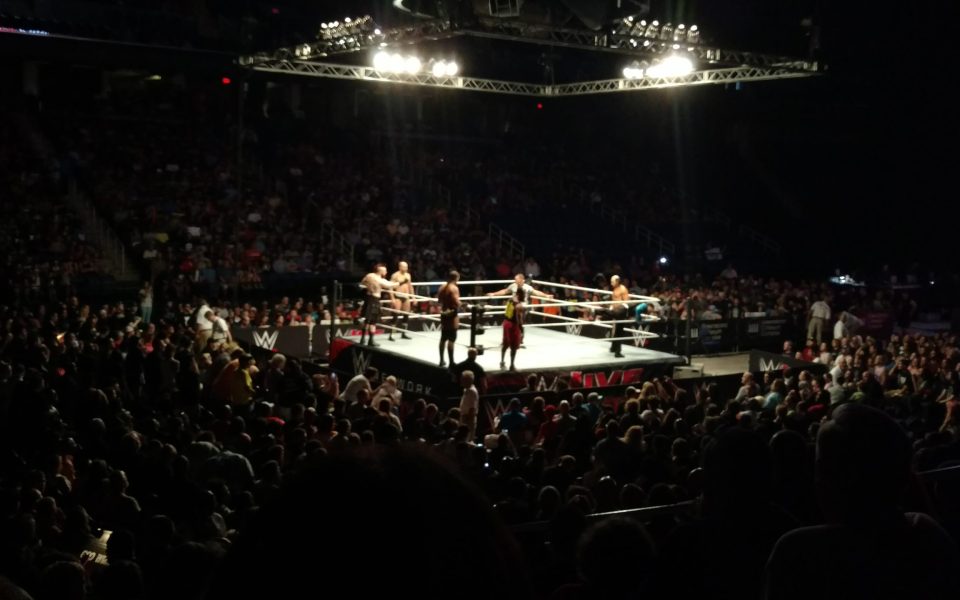Roman Reigns had Bray Wyatt on the ropes — there was no doubt about that. For any hope of shelter from the gale of nonstop walloping, Wyatt required divine, shirtless intervention.
Enter Samoa Joe.
Not long after Joe invaded the ring, he and Wyatt reversed the drubbing, mercilessly kicking the now-helpless Roman Reigns, who thrashed on the mat in agony.
But in roared Seth Rollins, ripping off his shirt and throwing it into the crowd before strutting to Reigns’ rescue. With a threat at once intimidating and geographically-savvy, he challenged Wyatt and Joe to an ultimate tag-team matchup: North Carolina style.
The crowd’s energy peaked; the night’s grand finale had begun.
More than 7,000 fans came to the Greensboro Coliseum for the WWE Live event on May 27. Throughout the thundering arena, many of the adults sat obediently while their kids shook their fists and screamed and took videos on their phones. Elsewhere sat patient children, looking on with embarrassment and a touch of panic as their caregivers shook their fists and screamed, fumbling for their own cameras.
The supporters’ enthusiasm and intimate knowledge, as well as the strong camaraderie between wrestler and fan, validated the spirit of the WWE and its many minions. But the ancient bloodthirst and malice spewing from both spectators and participants justified the event taking place at something called the coliseum.
Its discrepancies beg the question: What the hell is professional wrestling all about?
Traditionally, sports often draw audiences due to their competition and the lure of untold endings. They engage spectators because their outcomes are distinctly unknown; will, luck and superhuman spontaneity produce conclusions.
Professional wrestling doesn’t carry these same qualities into the ring. While the audience isn’t certain who will win a match, its members possess the knowledge that a victor has been decided, even choreographed, beforehand. In order for emotion — anger, fear, joy, surprise, defeat — to arise within the witness, a suspension of disbelief must precede each match.
For many traditional sports fans, this represents a leap they are unwilling to make. But what sets professional wrestling apart from other sports isn’t the event’s atmosphere, and certainly not the performers’ athletic ability. (In one skilled move that won him the contest, a wrestler front-flipped from the second-highest of the ropes that encircled the ring and landed deftly on his own back atop his opponent — a move that would put Montana Rep. Greg Gianforte to shame.) No, it’s the unique drama of the sport itself that many don’t consider.
More than traditional contests, professional wrestling pairs its athleticism with theatrical performance. While some may sneer at the WWE in comparison to competitions with less predictable winners, those critics are isolating the athletic component of the event, ignoring the dramatic one.
When we watch theater, film and drama, we understand that the characters we observe aren’t real. We know that actors lead very different lives from their fictional counterparts on the stage or screen; we know they were told where to stand and what to say. Yet we still laugh, cry, love, hate and glean knowledge and even experience from watching. We sometimes carry those understandings into the rest of our lives.
So when a professional wrestler draws vigor, passion and enmity from members of a crowd, they cheer not for a LeBron James, but a Han Solo. The wrestlers are heroes, villains, jesters, tyrants and commoners. Whether or not their feats are sudden, improvised and yet unknown to those around them doesn’t matter. Whether or not their fates are predetermined doesn’t affect how worthy of respect, adoration or contempt they prove to be.
And besides, that’s just the men.
After intermission at the Greensboro Coliseum, six women wrestlers took the ring. In a tag-team match, Mickie James, Sasha Banks and Bayley defeated Alexa Bliss, Nia Jax and Alicia Fox — a violent affair that provided all the intensity, athleticism and frenzy accompanying the men’s matches. Like Marvel’s Storm or Katniss Everdeen from The Hunger Games, the wrestlers proved to many young women (and men) in the crowd that the roles of aggressive, fierce warriors don’t need to be off-limits to anyone.
As Roman Reigns and Seth Rollins battled Samoa Joe and Bray Wyatt at the end of the night, Reigns — a WWE veteran — emerged as the most polarizing figure at the event. Calls of “Let’s go, Roman,” mingled with “Roman sucks,” revealed the opinions of thousands throughout the gym. (A clever young fellow in the stands insisted that jeers of “Roman noodle” — garnished often with “chicken flavor” — would galvanize the audience. It didn’t, though he attempted hundreds of times.)
Reigns and Rollins, considered villains to many, emerged victorious. But their detractors quickly scrambled as close to the ring as possible when the fight ended, as excited to get autographs, high-fives and selfies as those who supported the victorious pair.
At the Greensboro Coliseum, when the fights were over and the lights came on, even the hated became heroes.
Join the First Amendment Society, a membership that goes directly to funding TCB‘s newsroom.
We believe that reporting can save the world.
The TCB First Amendment Society recognizes the vital role of a free, unfettered press with a bundling of local experiences designed to build community, and unique engagements with our newsroom that will help you understand, and shape, local journalism’s critical role in uplifting the people in our cities.
All revenue goes directly into the newsroom as reporters’ salaries and freelance commissions.


Leave a Reply